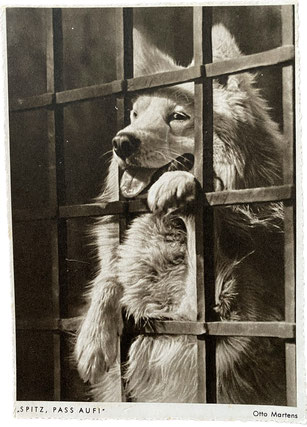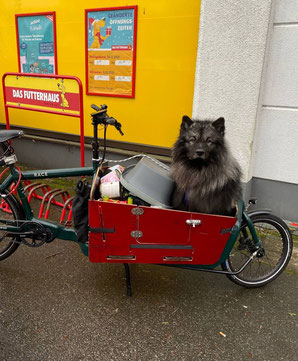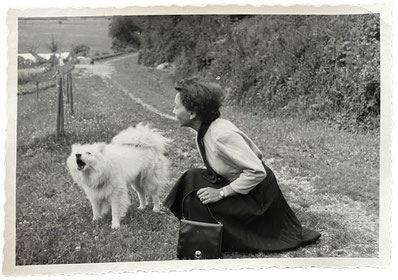How to train a German Spitz
The key to happiness is consistency
The Spitz - a breed for beginners?
Many breed descriptions of the German Spitz claim that it is an ideal dog for beginners, and that it is also very easy to train due to its high level of intelligence. I see this statement as very critical, because a really proper Spitz is certainly a lot, but not easy to train.
The large Spitzes in particular have been selected over the centuries for performance and for being able to work and make decisions independently (but in the spirit of their masters). Of course, this is still noticeable today in terms of education. They have a lot of their own ideas, they don't immediately bend to the will of their owner, and they are still very "dutiful" (the black Giant Spitzes more so than the whites Spitzes and the Wolfsspitzes).
The large German Spitz also has a particularly original nature and behavior and impresses with its primitive and clear manner - and that is exactly why this dog is not an "everybody's dog". This highly intelligent dog needs a confident handler and very clear and consistent leadership. Then the Spitz becomes a wonderful dog: resilient, very adaptable and (if trained well) also an excellent family dog. He is an enthusiastic hiker, insensitive to weather, long-lived, energetic, learns tricks quickly and happily and is enthusiastic about almost all activities because he would like to be there always and everywhere.
However, if there is a lack of clear, unambiguous guidance, it could happen that you experience something bad....
Leadership instead of bribery
Dressage and upbringing are two completely different things that also require completely different methods. If this difference is not recognized, the wrong remedy will inevitably be chosen. Since dressage achieves fairly good results in training, these successes lead one to believe that it would also work in education.
Example:
So when it is recommended to dissuade the “Leash-Rambo” from his undesirable behavior by using Vienna sausages as treats, the connection between his behavior and the satisfaction of his needs is not seen. The dog riots on the leash in order to fulfill its need for security by making a lot of noise in an attempt to drive away or impress a strange dog, for example. You can distract your dog from the situation with treats if necessary, but you don't change the fact that in the above-mentioned dog-human relationship, the dog obviously has to worry about his own safety because his human doesn't take care of the dog's security.
Education through treats is therefore not possible, also because these two situations are mutually exclusive. A classic oxymoron. So you can condition a dog with treats, but you cannot break the causal chain between aggression and satisfaction of the dog's needs, because you cannot release the dog from the responsibility that he has taken on in place of his human by distracting the dog with a treat.
A very appropriate excerpt from Michael Frey's crime novel "Hartmann und der böse Wolf" (Hartmann and the Big Bad Wolf):
“Leadership instead of mimicry is our motto, boomed Wolf. Leadership is the be-all and end-all in dog training. Whoever doesn't lead loses. The Alpha is the boss! You need that certain something, Mr. Hartmann, otherwise it won't work. Otherwise, the dog will mess with you. No matter how small he is. I have already experienced Chihuahuas that had a firm grip on s board of a DAX company. This guy easily ran a store with a hundred thousand employees and was bitten in the leg by his tiny dog every time he tried to reach the refrigerator at home. If you don't have charisma, I'll teach you. Body language is the thing. Of course, you can also hold a bratwurst in front of your dog's nose. Dogs will do anything for bratwurst. They're relatively simple creatures. But do you always have a bratwurst in your pocket when things get tricky, asks the wolf. No, says the wolf....
But to finish the thought. What do you do if you need a bratwurst and don't have any? Exactly. Nothing! Zero! Never mind! You'll poop there. You'll poop right next to the dog. That's exactly why the Wolf no training through bribery, no conditioning through treats and similar nonsense. Crystal-clear leadership is required. Do you dare to do that?"
Basics in training
Until the middle of the last century, the German Spitz - and we are primarily talking about the Wolfsspitz or Giant Spitz, since the small Spitz was always more of a domestic dog due to its petite nature - was a pure watchdog. A guard dog who had to take on the role of guardian and very often roamed freely, as he was so affectionate and loyal that he did not stray away from the property. He became an individualist who hated coercion.
But we only need to look at our modern way of life to see that it has changed dramatically. The freedom that the Spitz so urgently needs can often not be given to him, as most of them can hardly get off the leash.* The Spitz is often no longer just a guard dog, it is often part of the family, kept in the house and goes on travels. People's attitude towards dogs has changed overall.

Even the children who used to like to tease the dogs are today mostly nice and happy about dogs and often want to pet them - and, since our Spitzes have a heart for children, they are only too happy to oblige. With all this, the perspective of the Spitz has changed. The people they meet are often no longer intruders, but friendly and attentive to them. And the warning bark? "Spitz, don't overdo it with the yapping, it bothers the neighbors!" And the food also plays a role. It's plentiful - sometimes too plentiful - balanced and delicious. The Spitz no longer has to make do with the family's meager leftovers, as was the case just a few decades ago. Our upbringing is a shaping factor - also because we have to be considerate of our fellow human beings and the laws regarding dog ownership.
It is not uncommon to hear from older Spitz owners or breeders: "Yes, I used to have a German Spitz who was unique, so intelligent, so alert and who knows what else." Should such Spitzes no longer exist today? Secure. But can their typical Spitz personality still really develop today? The circumstances that make this difficult are listed above.
The breed standard says “The Spitz is naturally suspicious”. Support this facility! The young dog should not be petted by strangers, you want to stimulate his guardian qualities. For now, raise your young Spitz in his closest region. This and his family should be his only kingdom. The characteristic traits should be preserved, only in this way will the Spitz remain what he has always been: a loyal, incorruptible and good guardian for whom there is only his family and his family's property. You should build on these characteristics and take advantage of them. "These are the threads that later become chains to the Spitz." **
Training

German Spitzes are primarily watchdogs and develop the need to detect and, if necessary, ward off dangers at a very young age. The Spitz's specialization as a guard is also reflected in its abilities. So he has:
- Excellent vision and hearing ability
- An excellent sense of smell
- An amazing memory
- The tendency to only commit to one person
- The tendency to make independent decisions
- A lot of self-confidence
- A special ability to sprint quickly and have amazing jumping power
In order to control a Spitz, you have to be able to influence him educationally so that it:
- Not 24 hour guard
- Not everything is reported loudly
- Does not make any independent decisions when it comes to “threat prevention”.
Especially with the big Spitzes, it is particularly important to manage them with a lot of calm and even more consistency, and to always give them the certainty that you are taking care of them. Because a dog that can rely on its human knowing how things work has to take less action and therefore has less stress. Especially with a guard dog, it is necessary that his human creates a safe environment for him and thus releases him from his duties. To do this, the dog must experience its human as competent, which means that it must be able to clearly see from the actions of its human that the human is already protecting the immediate surroundings.
Discipline is the unloved child of pedagogy, but it is the foundation of all education. Discipline embodies everything that people detest: coercion, subordination, prescribed renunciation, suppression of instincts, restriction of one's own will. Bernhard Bueb
Guarding the front door

For the newly moved in dog, the apartment door quickly turns out to be the “weak point” of the house or apartment, because strangers can break into it at this location. Therefore, he will relatively quickly start checking and guarding exactly this part of the apartment. Now you can of course make sure that the young dog doesn't lie around in the hallway in front of the front door at all and instead point him to his assigned place to lie down, that would be one option. The other option is to take control of the front door yourself. This means that as soon as you hear a noise outside the door or in the stairwell, you go to the door (the dog stays behind you because he is on break) and open it or look through the keyhole so that the Spitz can see it whether danger is imminent. If this is not the case, you can then tell the dog that everything is fine. The way I do it is that I tap the dogs on the muzzle and say, “It’s okay!” It is important to use a very calm tone of voice. This is the only way the dog can see and experience that his owner is taking on the task of securing the territory, and will quickly learn that he now has free time.
What doesn't work: sitting on the sofa in the living room and shouting "Nooooo!" every time the young dog barks. You can't secure the environment by shouting "No!" and without looking - and the Spitz knows that too. Therefore, he will continue to take care of satisfying his need for security and, if necessary, move his sleeping place to the hallway in order to be able to better guard the door.

Of course, monitoring the front door initially means that you're constantly running back and forth between the sofa and the front door - especially if you live in an apartment building. Nevertheless, it's worth it, because this way you put an end to the myth of the yapping Spitz and also save your own nerves in the long term (we live on the first floor of an apartment building in Berlin and the neighbors have already told me several times how impressed they are by my dogs, you really don't hear them at all - even though Spitz are actually considered such bad barkers).
You shouldn't completely deprive the Spitz of his instinct to guard, because guarding is deeply anchored in his DNA - it's his task, his job. You can also take advantage of this heritage, because there is always something to guard. Whether the Spitz is guarding the apartment, the car or the shopping bags in front of the supermarket: all of this corresponds to his nature, is fun for him and also keeps him busy.
By the way, you always have to respond to what the Spitz tells you, check and assess it in a way that is visible to him. Dismissing the danger presented by the Spitz doesn't work. He will argue and say, “Yes, don’t you see it? Don't act stupid! Behind.....DANGER!!!”.
"Leash aggression"

If you don't liberate your Spitz from guarding permanently, he will of course want to ensure safety and order on the walk. This is usually expressed by the annoying leash-pulling and by the so-called “leash aggression”. Both actions have only one aim on the part of the Spitz: namely to clarify and secure the area. That's why it's important at this point not only to liberate the Spitz from his responsibility for safety, but also to limit his freedom of decision-making. What that means? The dog walks on a short leash BEHIND or at least next to you; but under no circumstances in front of people (and especially not on a flexible leash or a towline). Only limiting the scope for decision-making helps and has an educational effect. What doesn't work is thinking that you train your dog through conditioning or distraction with treats. This is dressage, but not education.
Walking behind the master also has an effect on defensive behavior: a Spitz guided in this way will leave it to the person to drive away scary monsters such as garbage cans that are just standing there or even scary-looking people. However, if the dog overtakes you, you stop this by forcefully stepping between the dog and its intended target and making it clear to it that this is NOT his job and that it is therefore illegally interfering with its owner's responsibilities. However, this boundary must be drawn very consistently, otherwise the dog can develop what is known as “leash aggression”.
Excessive territorial marking
Apparently, the inflationary marking of territory is typical for every dog; and the guarantee of this is an essential part of a species-appropriate attitude and guarantee of its well-being. But, is this really the truth? It is correct that clarifying and marking are typical dog behavior patterns. However, this only applies to dogs who have been given or given responsibility for their own safety (and possibly the safety of their owner and/or house and yard). Such a dog will always and constantly strive to maintain control of the surrounding territory. Typical signs of this are pulling the leash, constantly checking the environment, constantly marking and possibly keeping away any dangers, for example through barking (“leash aggression”). There's definitely another way to be stress-free, so lput your dog behind you when you go for a walk! This is less stressful for both of you - and also saves house walls, flower beds and trees.
Suitable hobbies for a German Spitz
The Spitz's strong photographic memory is particularly relevant for his task as a guard, as it means he can usually recognize even the smallest changes in his surroundings - for example, new objects that have arrived (everyone should know the garbage-can-monster that suddenly stands around on the street and the Spitz almost causes a heart attack). To do this, he primarily uses his eyes, but also by using his nose. The same applies to noises. Thanks to his excellent long-term memory, he can, for example, recognize all the neighbors in the house by their step after just a short time.
I show more hobby opportunities for German Spitzes in my article “Hobby and sports with Spitz”.

Conclusion
Spitzes are really intelligent and tend to outsmart their people if they are not led too laxly. They watch their pack very closely and try to figure out in their funny way how to undermine the rules, because they have excellent observation and combination skills. Many strict regulations have already become victim to the cunning charm of these dogs. But that's exactly what makes these dogs so lovable, and living with them is never boring. There is also a key to training the Spitz hidden here: get ahead of him and fool him too! This is funny, and you can get a lot of respect from your Spitz.
When it comes to training, you always have to look at your Spitz individually. Observe your Spitz and see what he is particularly good at and build on that! Because despite the necessary, crystal-clear leadership, a Spitz naturally also needs freedom to develop. Reconciling these two factors is not always easy and sometimes feels like walking a tightrope, but it is still worth it.
* Many dog owners do not realize that for every dog, except small breeds, the normal human walking pace is painfully slow. Our four-legged friends' natural mode of locomotion is a brisk trot. That's why dogs that are always walked on a leash out of consideration for road traffic are unfortunate creatures.
** Eyke Schmidt-Rohde in “Der Spitz”
28.09.23





